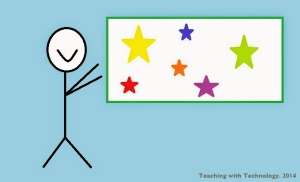What’s the first word that pops into your head when you read the following terms? One-room schoolhouse, matronly teacher, chalk, blackboard, quill, inkwell. For me, that term is: OLD SCHOOL.
What other terms could we add to that “old school” list? Teacher-centered environment? Rote memorization? Fact regurgitation? Are these aspects of a 21st century classroom? I hope not!
As more and more schools move toward a 1:1 technology initiative, the way we teach will most certainly change. This is an extremely disconcerting thought for many teachers: both veteran teachers and “newbies.” No longer will teachers be the “gatekeepers” of knowledge, and quite frankly, this concept is terrifying! We’ve all had those students who feel the need add more information to a lecture or presentation. Sometimes, those situations can make us feel uncomfortable and vulnerable in our so-called position of authority. If we have these experiences with the content we teach, imagine how much more frightening walking into the world of educational technology will be!
Technology isn’t going anywhere. It is here to stay; both in our personal lives and in our classrooms. So, instead of condemning educational technology (most likely out of fear), shouldn’t we embrace it? Absolutely!
Great Teachers + Educational Technology = AWESOME Instruction!
What role do schools play in helping teachers move into the 21st century? A huge and extraordinarily important role! Many school districts are seeing their professional development budgets slashed, and still have teachers who need instruction with implementing educational technology in their classrooms. Educational Technology is something teachers have to see, touch, and experiment with. There is not one specific tool that will work perfectly in every classroom. Teachers must be given the opportunity to see how different tools actually work before they can begin to ponder whether or not those tools will work in their classrooms. Educational technology is only beneficial if it works as TOOL for instruction!
What tools should teachers access to make the transition to 21st century education?
-
Educational Technology Learning Communities
-
Social media can be an amazing tool for teachers and administrators when it comes to gaining more information about educational technology. Many districts have stringent policies about using social media on their campuses, but the positive applications of social media for teachers is undeniable. Teachers can join communities on Google+ to access a wealth of information about using technology in the classroom. Teachers can follow technology specialists on Twitter and search hashtags that are relevant to their content and technology usage. Social media provides an awesome way for educators to not only learn about new technology, but also connect and share experiences and ideas with educators from around the world.
-
Webinars
-
Webinars are often a cheaper alternative to traditional workshops or professional development opportunities. Some are even free! Teachers can locate webinars on virtually any topic; flipped learning, using iPads in the classroom, connected learning, and more! Many webinars are offered after school hours, which allows teachers to stay in their classrooms, not losing valuable instructional time. Webinars can often be found recorded on YouTube for anyone to watch anytime.
-
Books!
-
Many traditional books as well as eBooks are available that provide suggestions and ideas for implementing technology in the classroom. Books that describe new teaching strategies and tools, such as “Flip Your Classroom” by Aaron Sams and Jon Bergmann. As its title implies, “Flip Your Classroom” provides teachers with the basics of the flipped model, suggested technologies to use to create content videos, and applications for both core and non-core classrooms.
-
Online Courses
-
Many online courses are available to help teachers learn about new educational technologies. Popular sites such as the Global Education Database, Sophia.org, and of course Google for Education have a wealth of helpful, accessible, and feasible alternatives to traditional professional development workshops. Best of all, teachers can access this information at a time that is convenient for them!
Traditional workshops and inservices are also extremely beneficial for teachers learning about the shift toward classroom technology. However, the methods mentioned provide a less expensive and practical alternative to conventional professional development opportunities.
How are you and your colleagues preparing for technology integration?
Thanks for reading 🙂

Leave a Reply